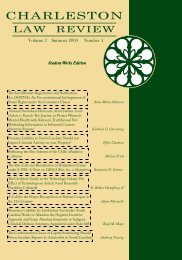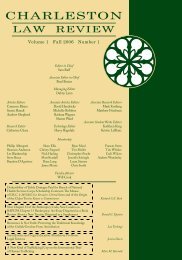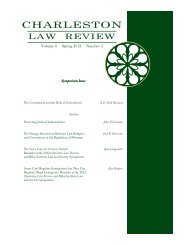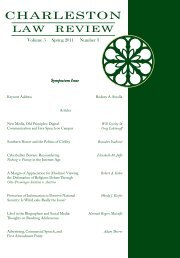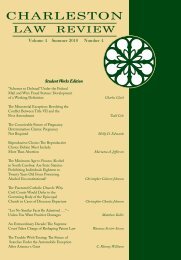Volume 5 Winter 2011 Number 2 - Charleston Law Review
Volume 5 Winter 2011 Number 2 - Charleston Law Review
Volume 5 Winter 2011 Number 2 - Charleston Law Review
You also want an ePaper? Increase the reach of your titles
YUMPU automatically turns print PDFs into web optimized ePapers that Google loves.
CHARLESTON LAW REVIEW [<strong>Volume</strong> 5theories articulated within these families are: (1) “Learningstyles and preferences are largely constitutionally based,including the four modalities,” which are commonly known by theacronym “VAKT,” or visual, auditory, kinesthetic, tactile; (2)“Learning styles reflect deep-seated features of the cognitivestructure, including ‘patterns of ability’”; (3) “Learning styles areone component of a relatively stable personality type”; (4)“Learning styles are flexibly stable learning preferences”; and (5)There are different “learning approaches, strategies, orientationsand conceptions of learning.” 38 Although some might talk ofa singular learning “style,” the fact is that learningstyle proponents promote conceptually different, and oftencontradictory, definitive “styles,” which may depend onsuch characteristics as individual “intelligence, personality,information processing mechanisms, social interaction needs, andinstructional preferences,” only some of which are amenable tochange. 39Of the thirteen models thoroughly examined in the CoffieldStudy, only a few appear to have an identifiable presence in thescholarship of legal education. These include the Dunn andDunn learning styles model, 40 the Kolb Learning Style Inventory(LSI), 41 and the Myers-Brigg Type Indicator, 42 although othersamong other things, in-depth analysis of the origins and influence of thetheories, analysis of the learning style instruments associated with the theories,evaluation of the reliability and validity of the measurements, implications forpedagogy, and empirical evidence for pedagogical impact. Id. at 11.38. Id. at 9, Figure 4.39. Jacobson, A Primer on Learning Styles, supra note 9, at 146 (citingCHARLES CLAXTON &PATRICIA MURRELL, LEARNING STYLES: IMPLICATIONS FORIMPROVING EDUCATIONAL PROCESSES 7 (1987)); see also Vernellia R. Randall, TheMyers-Briggs Type Indicator, First Year <strong>Law</strong> Students and Performance, 26CUMB. L. REV. 63, 7075 (1995) (summarizing the factors that influencelearning according to different learning theories); Jacobson, How <strong>Law</strong> StudentsAbsorb Information, supra note 12, at 176 (noting that “learning styles aredetermined by many things, some of which may not be very susceptible tochange, some of which may not be readily assessable, and some of which maynot be particularly relevant to the problems the student may be having inlearning law and legal analysis”).40. See, e.g., Boyle & Dunn, Teaching <strong>Law</strong> Students, supra note 12; Boyle,Minneti & Honigsfeld, supra note 12.41. See Steven Hartwell, Six Easy Pieces: Teaching Experientially, 41 SANDIEGO L. REV. 1011 (2004) (applying Kolb’s Experiential Learning model to the144



